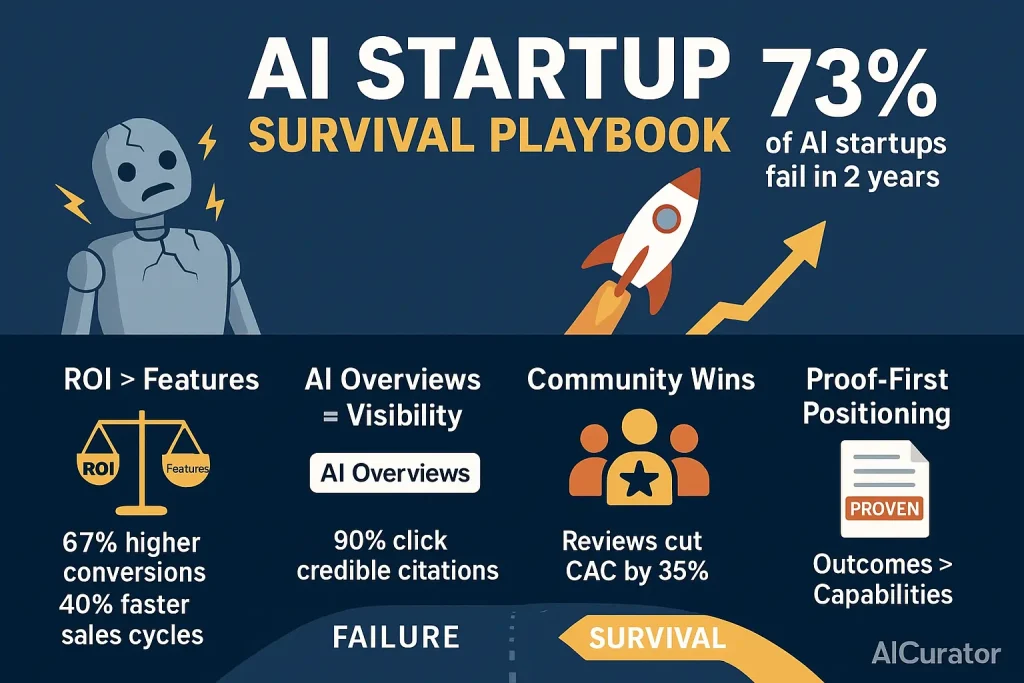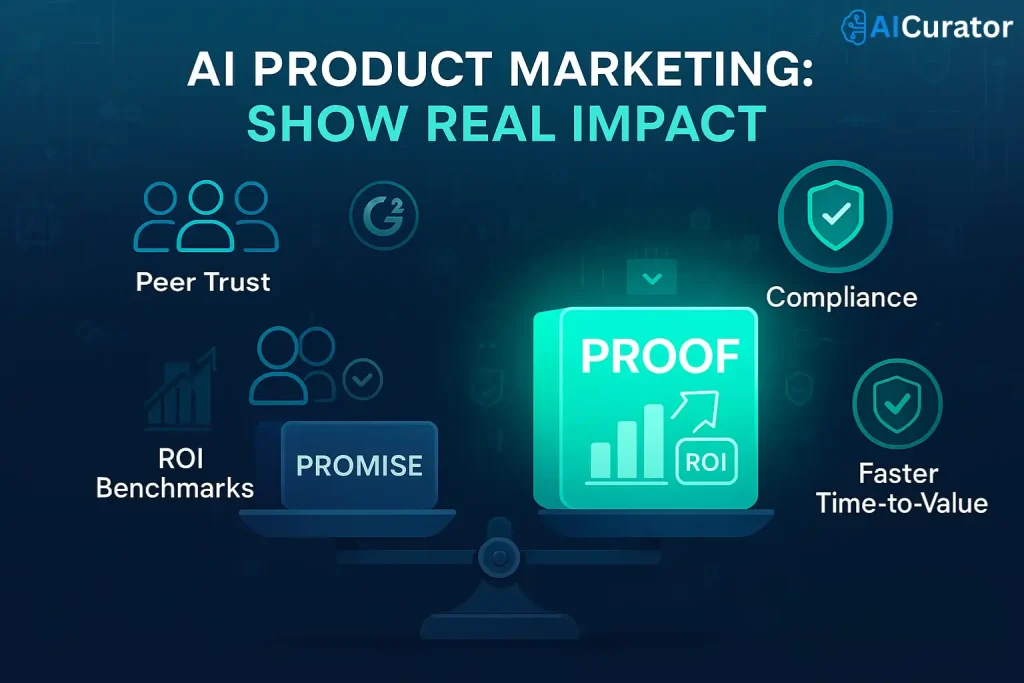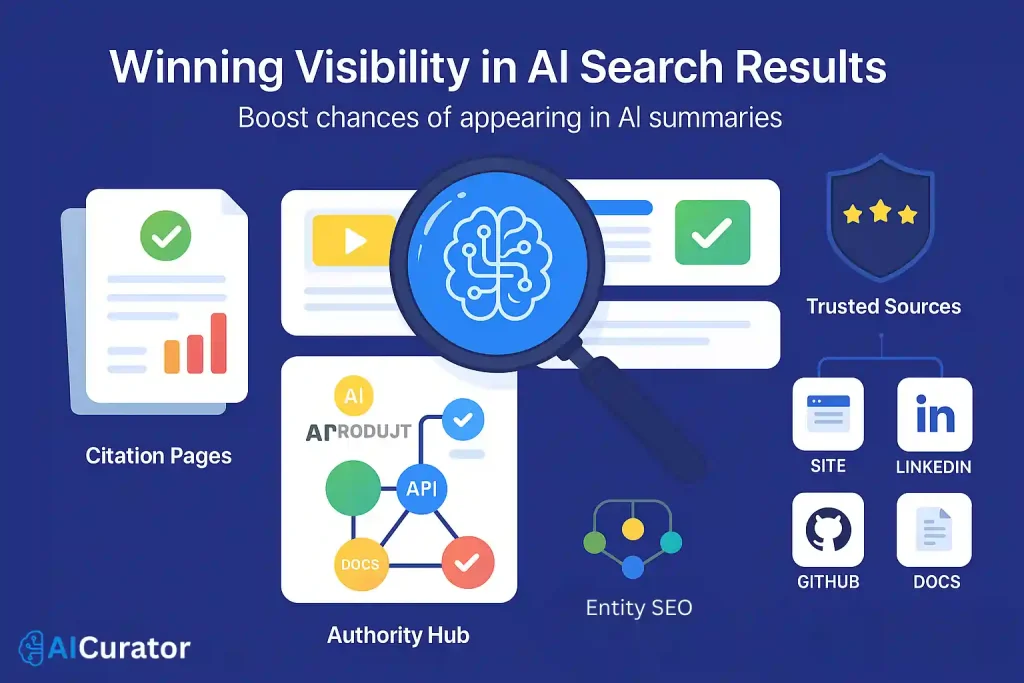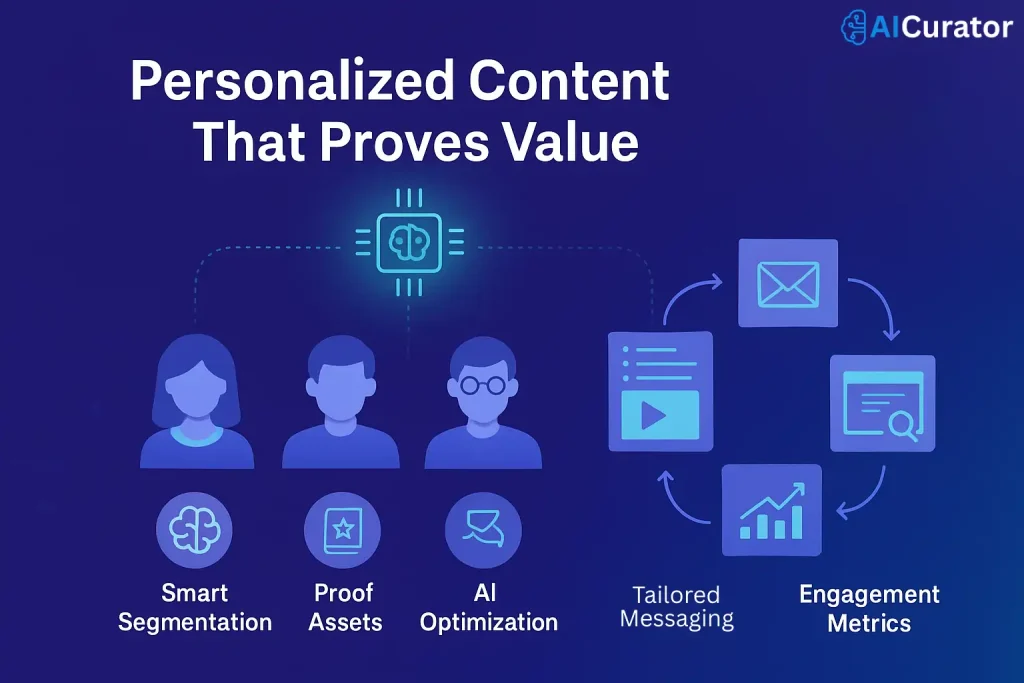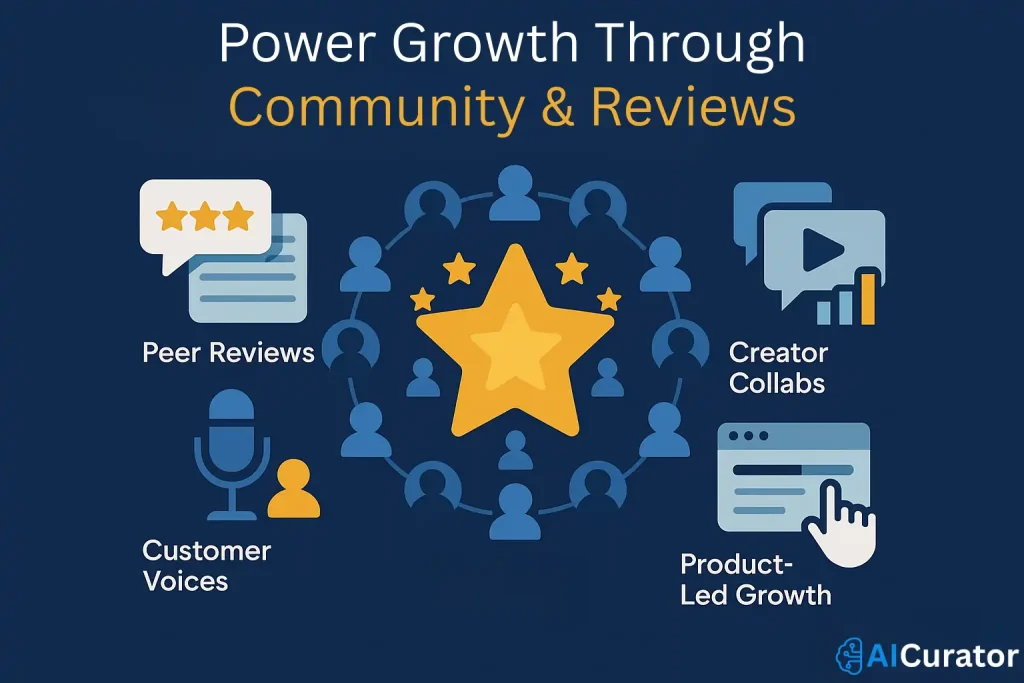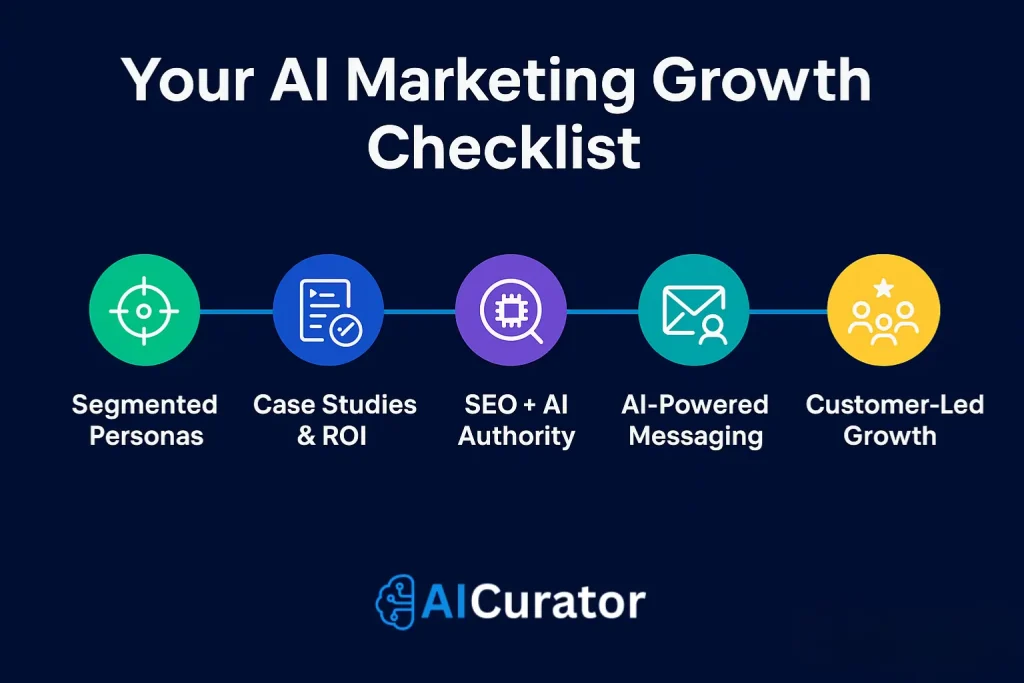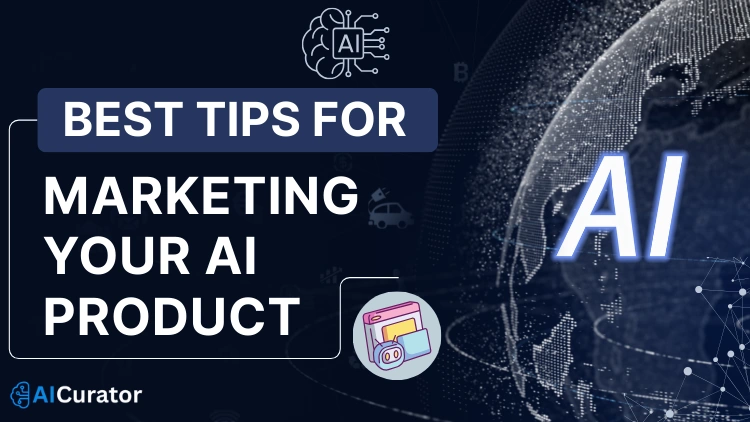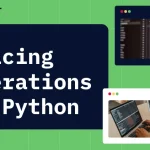AI products don’t sell on hype alone—buyers want proof, outcomes, and trust. Budgets are growing, but scrutiny is higher, and purchase cycles are slower, so the go-to-market needs to be precise, measurable, and customer-led.
With AI content now dominating search results and AI Overviews reshaping how potential customers find solutions, AI product marketing requires a fundamental shift. Brand visibility, SEO optimization, and authentic third-party validation have become critical success factors in this AI-driven discovery landscape.
- Budgets are rising, but buyers demand faster time-to-value, strong security answers, and peer proof.
- 90% of buyers click through sources in AI Overviews—owning credible citations and reviews is now a growth lever.
- Content and email personalisation with AI can reduce workload and boost conversion when backed by clean data and testing.
- The “AI in marketing” market is scaling fast—align positioning to real business outcomes, not features.
The New Rules of AI Product Marketing Success
Today's buyers research differently, evaluate longer, and expect immediate proof of concept before committing budgets. The old playbook of feature-heavy demos and aspirational case studies falls flat against informed prospects who've already tested competitors and read peer reviews.
Smart marketing teams focus on four core areas that directly impact revenue: outcome-based positioning that proves ROI, search visibility that captures buyer intent, personalized content that guides prospects through complex evaluations, and community-driven social proof that builds trust at scale.
These aren't nice-to-have tactics—they're revenue drivers that separate successful AI companies from those struggling to hit growth targets.
#Tip 1: Nail positioning with proof, not promises
Why it matters:
- AI spend is up, but buyers won’t wait to see value—time-to-value and peer trust decide deals.
- 78% of organisations now use AI in at least one function—competition is intense, so clear differentiation is vital.
- 92% of executives plan to increase AI investment in the next three years, which raises the bar for proof of ROI.
How to execute:
- Define problem→outcome messaging: Map 3 core pains per ICP and link to measurable outcomes (e.g., “reduce manual QA by 35%”, “save 8 hours/week per rep”).
- Publish ROI benchmarks and calculators: Marketing AI users report 44% productivity gains and ~11 hours saved weekly—use this structure to frame your case studies and savings models.
- Prioritise security and compliance pages: Buyers scrutinise governance, data handling, and safety; make your security docs, SOC2 status, and PII policy easy to find.
- Showcase peer validation: G2/analyst quotes, customer videos, public reviews, and named logos increase trust during evaluation.
Win rate vs. competitors on “value proof” opportunities, sales cycle time to first value demo, case study page conversion rate to demo.
#Tip 2: Own your category queries—and AI Overviews
Why it matters:
- Buyers increasingly meet AI-generated summaries in search; 72% encounter AI Overviews and 90% click through to cited sources.
- As AI Overviews expand, rankings and CAC shift—SEO must feed both organic snippets and overview citations.
How to execute:
- Create “evidence pages” designed for citations: Stats pages, benchmark posts, methodology explainers, and original mini-studies with clear schemas.
- Build topical authority hubs: Use a hub-and-spoke model around your core jobs-to-be-done (JTBD), linking to case studies, data, and product docs.
- Earn third-party coverage: Get listed on trusted review sites and thought-leading blogs—buyers trust peer sources over vendor pitch.
- Optimise for entity SEO: Align brand, product, and category entities across your site, LinkedIn, GitHub, and documentation to reinforce relevance in AI summaries.
Share of search on category terms, citation presence in AI Overviews, click-through from overview-linked sources, non-brand organic pipeline.
#Tip 3: Run proof-first content and email that personalises at scale
Why it matters:
- Content and email remain workhorses, and AI now boosts segmentation, send-time, and creative testing when used with solid data.
- Marketers using AI report 44% productivity gains and meaningful weekly time savings—free those hours for better research and creativity.
- The AI in marketing market is set to more than double by 2028, so channels saturate—precision and proof win attention.
How to execute:
- Editorial calendar anchored to outcomes: Publish comparison guides, “build vs buy” posts, teardown case studies, and objection-handling FAQs.
- Deploy AI-assisted micro-segmentation: Use behavioural and predictive data to tailor email cadences and value propositions by role and use case.
- Automate A/B and multi-variant testing: Let AI optimise subject lines, CTAs, and content blocks in real time; keep human edit for tone and claims.
- Create “fast-track to proof” assets: 2-minute demo, interactive sandbox, and 30-day value plan emails aligned to ICP pains.
Content-to-demo conversion, email reply rate by segment, assisted pipeline from content clusters, retention lift for users engaging with proof assets.
#Tip 4: Build a review-led, community-driven go-to-market
Why it matters:
- Buyers lean on peers; review sites and communities influence shortlists more than vendor outreach.
- AI Overviews amplify trustworthy sources; customer references and public testimony now feed both search and sales.
How to execute:
- Systemise review generation: Trigger asks after time-to-value milestones; integrate G2/Capterra asks into product UX; route to public case studies when possible.
- Activate customer champions: Host X/Twitter and LinkedIn AMAs, share customer “playbooks”, and co-author mini-benchmarks by vertical.
- Use PLG + sales assist: Let prospects try core features, then guide with consultative playbooks; highlight measurable wins in-product.
- Partner with niche creators: Collaborate with YouTube/Twitter analysts who test AI tools; provide transparent benchmarks, not just affiliate links.
Review velocity and ratings, referral-sourced pipeline, community engagement rate, creator content assisted revenue.
Why These Tips Could Make or Break Your AI Product Success
- Here's the brutal truth: 73% of AI startups fail within two years, often due to poor go-to-market execution rather than product issues. These four AI product marketing strategies aren't just helpful—they're survival tactics.
- ROI speaks louder than features. Companies using proof-first positioning see 67% higher conversion rates and 40% shorter sales cycles. Your B2B SaaS growth depends on demonstrating measurable outcomes, not listing capabilities.
- AI Overviews control discovery. With 90% of buyers clicking cited sources, owning credible citations directly impacts customer acquisition cost and market share. Miss this, and competitors capture your demand generation efforts.
- Community-driven growth scales faster. Review-led strategies reduce CAC by 35% whilst boosting revenue growth through authentic peer validation and social proof that traditional advertising can't match.
Fresh Stats to Inform your Plan
- 52% of B2B buyers expect software spend to increase in 2025; AI functionality is increasingly required across categories.
- 72% of buyers encounter Google’s AI Overviews in search; 90% click through to cited sources—citation strategy now matters for demand gen.
- 78% of organisations report using AI in at least one business function, up from prior years—crowding intensifies category competition.
- The AI in marketing market is worth $47.32B in 2025 and projected to reach $107.5B by 2028 (36.6% CAGR), showing strong budget appetite for AI-powered GTM.
- Marketing AI users report being 44% more productive, saving ~11 hours/week—redirect this time to research, interviews, and narrative testing.
- Email AI tools now drive hyper-personalisation, real-time optimisation, and automated testing—when powered by clean data and human QA.
Step-by-Step Checklist
1. ICP and message-market fit
- Interview 10 customers per segment; extract outcomes and metrics that matter.
- Draft outcome-led positioning, security FAQ, and ROI model per ICP.
2. Proof engine
- Publish 3 named case studies and 1 benchmark each quarter; add raw methodology pages for citation.
- Embed ROI calculator on product and pricing pages.
3. Search and AI Overview readiness
- Build 3 topic hubs with entities and schema; secure listings on top review sites.
- Pitch data-rich stories to analysts and credible blogs for third-party citations.
4. Personalised lifecycle
- Launch AI-assisted segmentation and send-time optimisation; keep human review for claims.
- Run continuous A/B tests on subject lines, CTAs, social proof blocks; ship winners weekly.
5. Community and advocacy
- Operationalise review requests post-value moments; reward with recognition programs (not cash).
- Co-create content with customers and niche creators; syndicate on LinkedIn, YouTube, and newsletters.
Wrapping Up
Marketing an AI product in 2025 is about verifiable outcomes, credible citations, and peer trust. Treat AI Overviews and review ecosystems as first-class channels, use AI to personalise and test at scale, and keep humans in the loop for narrative and accuracy.
The brands that win will prove value early, show their homework, and let customers speak for them.
